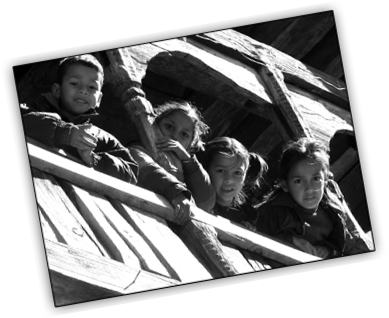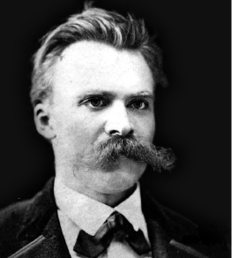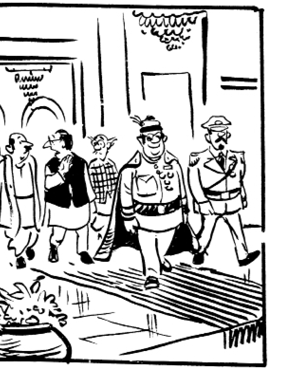Table of Contents

Chapter 9
Peace
Overview
The screaming media reports on wars, terrorist attacks and riots constantly remind us that we live in turbulent times. While actual peace remains elusive, the word itself seems to have become quite popular. It springs readily to the lips of politicians, journalists, industrialists, educators and army chiefs. It is also cited as a cherished value in a wide variety of documents including textbooks, constitutions, charters and treaties. As the idea of peace is readily invoked and the desirability of pursuing peace is rarely questioned we may think that the meaning of this concept needs no further clarification. However, this is not the case. As we will see later, the seeming consensus around the idea of peace is a relatively recent phenomenon. Over the years, the meaning and value of peace has been assessed fairly differently.

The advocates of peace face many questions:
What exactly is peace? And, why is it so fragile in today’s world?
What can be done to establish peace?
Can we use violence to establish peace?
What are the main reasons for the growing violence in our society?
These are questions that we will examine in greater detail in this chapter.
9.1 Introduction
Like ‘democracy’, ‘justice’ and ‘human rights’, ‘peace’ has become a buzzword. But we must remember that this seeming consensus on the desirability of peace is relatively recent. Many important thinkers of the past wrote about peace in negative terms.
The nineteenth century German philosopher Friedrich Nietzsche was one of those who glorified war. Nietzsche did not value peace because he believed that only conflict could facilitate the growth of civilisation. Several other thinkers have similarly condemned peace and commended strife as a vehicle of individual heroism and social vitality. The Italian social theorist, Vilfredo Pareto (1848–1923), argued that people who were able and willing to use force to achieve their goals constituted the governing elites in most societies. He described them as ‘lions’.

Friedrich Nietzsche
This is not to suggest that the cause of peace had no champions. In fact, it occupied a central place in the original teachings of almost all religions. The modern era too has witnessed ardent advocates of peace, both in the spiritual and secular domains. Mahatma Gandhi would figure prominently among them. However, the contemporary preoccupation with peace can be traced to the atrocities of the twentieth century, which resulted in the death of millions of human beings. You may have read about some of these events in your history textbooks: the rise of Fascism, Nazism and the World Wars. Closer home in India and Pakistan we have experienced the horrors of Partition.
Many of the aforesaid calamities involved the use of advanced technology to wreak havoc on an unprecedented scale. Thus, Germany ‘carpet-bombed’ London during the Second World War and the British responded by sending 1000-bomber raids to attack German cities. The war ended with the USA dropping atom bombs on the Japanese cities, Hiroshima and Nagasaki. At least 1,20,000 people died immediately from the two attacks and many more died later due to the effects of nuclear radiation. Nearly 95 per cent of the casualties were civilians.
The post-war decades were marked by intense rivalry between two superpowers–the capitalist USA and the communist USSR—for world supremacy. Since nuclear weapons had become the new currency of power, both countries began to make and stockpile them on a large scale. The Cuban Missile Crisis of October 1962 was a particularly dark episode in this unfolding military competition. It began when American spy planes discovered Soviet nuclear missiles in neighbouring Cuba. The USA responded by organising a naval blockade of Cuba and threatening military action against the USSR, if the missiles were not removed. This eyeball-to-eyeball confrontation ended when the Soviet Union withdrew the missiles. During the two weeks it lasted, the crisis had brought humanity perilously close to the brink of total destruction.
So, if people praise peace today, that is not merely because they believe it to be a good idea. Humanity has learnt to value peace after paying a huge price for its absence. The spectre of tragic conflict continues to haunt us. Today life is more insecure than ever before as people everywhere face a growing threat from terrorism. Peace continues to be valuable, partly because dangers to it are ever present.
Do
Let’s Do It
Read the novel The flowers of Hiroshima written by Edita Morris. Note how the use of the atomic bomb continued to traumatise the people for long.
9.2 The Meaning of Peace
Peace is often defined as the absence of war. The definition is simple but misleading. This is because war is usually equated with armed conflict between countries. However, what happened in Rwanda or Bosnia was not a war of this kind. Yet, it represented a violation or cessation of peace. While every war leads to absence of peace, every absence of peace need not take the form of war.
The second step in defining peace would be to see it as absence of violent conflict of all kinds including war, riot, massacre, assassination, or simply physical attack. This definition is clearly better than the earlier one. Yet, it does not take us very far. Violence is often rooted in the very structure of society. Social institutions and practices that reinforce entrenched inequalities of caste, class and gender, can also cause injury in subtle and invisible ways. If any challenge is made to these hierarchies by oppressed classes it may also breed conflict and violence. ‘Structural violence’ of this kind may produce large-scale evil consequences. Let us look at a few concrete instances of such violence arising from caste hierarchy., class disparity, patriarchy, colonialism, and racism/communalism.

Forms of Structural Violence
The traditional caste system treated certain groups of people as asprishya or untouchable. Till it was outlawed by the Constitution of independent India, the practice of untouchability subjected them to social exclusion and deprivation of the worst sort. The country is still struggling to erase the scars and relics of this ugly custom. While a social order based on class appears to be more flexible, it too generates a great deal of inequality and oppression. In the developing countries a majority of the labouring classes are confined to the informal sector where the wages and conditions of work are abysmal. A sizeable underclass exists even in the developed countries.
Patriarchy entails a form of social organisation that results in the systematic subordination of, and discrimination against, women. Its manifestations include selective abortion of female foetuses, denial of adequate nourishment and education to the girl-child, child-marriage, wife battering, dowry-related crimes, sexual harassment at the workplace, rape, and honour killing. The low child sex ratio (0-6 years) — 919 females per 1000 males — in India, as per the 2011 Census, is a poignant index of the ravages of patriarchy.
Colonialism in the sense of prolonged and direct subjection of a people to alien rule is now a rare phenomenon. But the ongoing Palestinian struggle against Israeli domination shows that it has not disappeared completely. Besides, the former colonies of European imperialist countries are yet to recover completely from the forms of manifold exploitation they suffered during the colonial era.
Racism and communalism involve the stigmatisation and oppression of an entire racial group or community. Though the notion that humanity can be divided into distinct races is scientifically spurious, it has been used to justify insidious practices such as Negro slavery in the United States of America (until 1865), the slaughter of Jews in Hitler’s Germany, and apartheid—a policy followed until 1992 by the White-controlled government in South Africa, which treated the majority Black people of the country as second-class citizens. Racial discrimination still continues covertly in the West and is now often directed against immigrants from countries in Asia, Africa and Latin America. Communalism may be seen as the South Asian counterpart of racism where the victims tend to be minority religious groups.
The psychological and tangible harm suffered by the victims of violence often creates grievances that persist over generations. Sometimes they may give rise to fresh bouts of conflict when provoked by some incident or even remark. We have examples of long-term grievances being harboured by communities against each other in South Asia, such as those stemming from the violence unleashed during the partition of British India in 1947.
A just and lasting peace can be attained only by articulating and removing the latent grievances and causes of conflict through a process of dialogue. Hence the ongoing attempts to resolve problems between India and Pakistan also include promoting increased contacts among people in all walks of life.
![1446.png]() Let’s Think
Let’s Think
Which of the following views do you agree with and why?
“All wrong-doing arises because of mind. If mind
is transformed can wrong-doing remain?”
– Gautam Buddha
“I object to violence because when it appears to do good, the good is only temporary; the evil it does is permanent”
– Mahatma Gandhi
“Ye shall be those whose eyes ever seek for an enemy…ye shall love peace as a means to new wars—and the short peace more than the long. You I advise not to work, but to victory. Let your work be a fight, let your peace be a victory”
– Friedrich Nietzsche
Eliminating Violence
The Constitution of the United Nations Educational, Scientific and Cultural Organisation rightly observes: “Since wars begin in the minds of men, it is in the minds of men that the defences of peace must be constructed”. Several age-old spiritual principles (e.g., compassion) and practices (e.g., meditation) are geared precisely to the facilitation of such an endeavour. Modern healing techniques and therapies like psychoanalysis can perform a similar function.
However, we have noted that violence does not originate merely within the individual psyche; it is also rooted in certain social structures. The elimination of structural violence necessitates the creation of a just and democratic society. Peace, understood as the harmonious coexistence of contented people, would be a product of such a society. It can never be achieved once and for all. Peace is not an end-state, but a process involving an active pursuit of the moral and material resources needed to establish human welfare in the broadest sense of the term.
9.3 Can Violence Ever Promote Peace?
It has often been asserted that violence — though it is an evil — can sometimes be a necessary prelude to bringing about peace. It may be argued that tyrants and oppressors can be prevented from continuing to harm the populace only by being forcibly removed. Or the liberation struggles of oppressed people can be justified even though they may use some violence. But resort to violence, however well meaning, could turn out to be self-defeating. Once deployed, it tends to spin out of control, leaving behind a trail of death and destruction.
It is for this reason that pacifists, who consider peace to be a supreme value, take a moral stand against the use of violence even for attaining just ends. They too recognise the need to fight oppression. However, they advocate the mobilisation of love and truth to win the hearts and minds of the oppressors.
This is not to underestimate the potential of militant but non-violent form of resistance. Civil disobedience is a major mode of such struggle and it has been successfully used to make a dent in structures of oppression; a prominent instance being Gandhi’s deployment of satyagraha during the Indian Freedom Movement. Gandhi took his stand on justice and appealed to the conscience of the British rulers. If that did not work, he put moral and political pressure on them by launching a mass movement involving open but non-violent breaking of the unjust laws. Drawing inspiration from him, Martin Luther King waged a similar battle in the 1960s against anti-Black racial discrimination in the USA.
Do
Let’s Do It
List the names of a few Nobel Peace Prize winners. Write a note on any one of them.
![1488.png]() LET'S THINK
LET'S THINK
The Khmer Rouge regime in Cambodia was a particularly horrific example of the counter-productive nature of revolutionary violence. An outcome of the insurrection led by Pol Pot, the regime sought to institute a communist order geared to the liberation of the oppressed peasantry. During 1975–1979, it let loose a reign of terror that caused the death of approximately 1.7 million people (21per cent of the country’s population). This was one of the bleakest human tragedies of the previous century.
The systematic deployment of violence by radical movements to attain apparently desirable objectives may not always have such dramatically appalling consequences. But in the process, it frequently assumes an institutional form, thereby becoming an integral part of the resulting political order. A case in point is the FLN (National Liberation Front), which led the Algerian independence movement by using violent means. While it liberated the country from the yoke of French imperialism in 1962, the FLN regime soon degenerated into authoritarianism and triggered a backlash in the form of Islamic fundamentalism.

MAHATMA GANDHI ON NON-VIOLENCE
LET’S DEBATE
9.4 Peace and the State
It is often argued that the division of world into separate sovereign states is an impediment to the pursuit of peace. As each state sees itself as an independent and supreme entity, it tends to protect its own perceived self-interest. While the pursuit of peace requires that we see ourselves as part of the larger humanity, states tend to make distinctions between people. To pursue the interest of their citizens they are willing to inflict injury upon others.
Besides, in today’s world each state has consolidated instruments of coercion and force. While the state was expected to use its force, its army or its police, to protect its citizens, in practice these forces could be deployed against its own members to suppress dissent. This is most clearly evident in authoritarian regimes and military dictatorships, like the one currently ruling Myanmar. The long-term solution to such problems lies in making the state more accountable through meaningful democratisation and reining it in via an effective system of civil liberties. This is the route taken by the post-apartheid regime in South Africa, which is one of the prominent political success stories of recent years. The struggle for democracy and human rights is thus closely linked to the safeguarding of peace.
A poignant dilemma arises from the tendency of many states to use violent means for achieving their objectives in the international arena, especially for capturing territory and natural resources. The resulting contention can escalate into a full-scale war. Thus, in 1990, Iraq invaded its small, oil-rich neighbour Kuwait. It justified the war by asserting that Kuwaiti territory had been an Iraqi province arbitrarily cut off by imperialism, and by accusing Kuwait of slant drilling into Iraq’s oil supplies. The invasion was eventually repulsed by a US-led military coalition. Conflict of this kind is an ever-present possibility in a global system devoid of an effective world government. It is also exacerbated by vested interests like the armament industry, which find war a profitable proposition.
Let’s Do It
Collect material on Gandhi’s various methods of Satyagraha used in South Africa, Champaran and in Dandi March. If possible read the book Pahala Girmatiya by Giriraj Kishore.
9.5 Different approaches to the pursuit of peace
Different strategies have been used for the pursuit and maintenance of peace. These have been shaped by three distinct approaches. The first approach accords centrality to states, respects their sovereignty, and treats competition among them as a fact of life. Its main concern is with the proper management of this competition, and with the containment of possible conflict through inter-state arrangements like ‘balance of power’. Such a balance is said to have prevailed in the nineteenth century when the major European countries fine-tuned their struggle for power by forming alliances that deterred potential aggressors and prevented the outbreak of a large-scale war.
The second approach too grants the deep-rooted nature of inter-state rivalry. But it stresses the positive presence and possibilities of interdependence. It underscores the growing social and economic cooperation among nations. Such cooperation is expected to temper state sovereignty and promote international understanding. Consequently global conflict would be reduced, leading to better prospects of peace. An example frequently cited by advocates of this approach is that of post-World War II Europe which secured durable peace by graduating from economic integration to political unification.
Unlike the first two approaches, the third considers the state system to be a passing phase of human history. It envisages the emergence of a supra-national order and sees the fostering of a global community as the surest guarantee of peace. The seeds of such a community are found in the expanding interactions
and coalitions across state boundaries that involve diverse non-governmental actors like multinational corporations and people’s movements. The proponents of this approach argue that the ongoing process of globalisation is further eroding the already diminished primacy and sovereignty of the state, thereby creating conditions conducive to the establishment of world peace.
Pacifism
The United Nations may be said to embody elements of all the three approaches. The Security Council, which gives permanent membership and veto power (the right to shoot down a proposal even if it is supported by other members) to five dominant states, reflects the prevalent international hierarchy. The Economic and Social Council promotes inter-state cooperation in several spheres. The Commission on Human Rights seeks to shape and apply transnational norms.
9.6 Contemporary Challenges
While the U.N.O. has several noteworthy achievements to its credit, it has not succeeded in preventing and eliminating threats to peace. Instead, dominant states have asserted their sovereignty and sought to shape regional power structures and the international system itself in keeping with their own perceptions and priorities. To this end, they have even resorted to direct military action against and occupation of foreign territories. The recent US intervention in Afghanistan and Iraq is a glaring example of such conduct. Numerous lives have been lost in the ensuing warfare.
The rise of terrorism is partly a response to the self-serving and ham-handed conduct of the aggressive states. Terrorists currently pose a great threat to peace through an adroit and ruthless use of modern weapons and advanced technology more generally. The demolition of the World Trade Centre (New York, USA) by Islamic militants on 11 September 2001 was a striking manifestation of this sinister reality. The use of biological/chemical/nuclear weapons of mass destruction by these forces remains a frightening possibility.
The global community has failed to curb the rapacity of the domineering powers and the guerrilla tactics of the terrorists. It has also often served as a mute spectator of genocide — the systematic massacre of an entire group of people. This became particularly evident in Rwanda — an African country that witnessed the murder of nearly half a million Tutsis by Hutus during 1994. Despite the availability of intelligence before the killing began and subsequent international media coverage of the genocide as it unfolded, there was no international intervention. The UN refused to authorise its peace-keeping operation in Rwanda to stop the carnage.
All this is not to say that peace is a lost cause. After World War II, countries like Japan and Costa Rica decided not to maintain military forces. Several parts of the world have witnessed the creation of nuclear-weapon-free zones where the use, development or deployment of nuclear weapons is banned through an internationally recognised treaty. Today there are six such zones which have been achieved or are in the process of acceptance, covering the Antarctic territory, Latin America and the Caribbean, South-East Asia, Africa, the South Pacific, and Mongolia. The disintegration of the USSR in 1991 put a full stop to the era of military (especially nuclear) rivalry between the super powers and removed a major threat to international security.
Besides, the contemporary era has witnessed the rise of numerous popular initiatives aimed at fostering peace. These are often collectively described as the peace movement. The devastation caused by the two World Wars galvanised the movement. It has since gathered momentum and gained a large following across geographical and political barriers. The movement is sustained by people from diverse walks of life and includes workers, writers, scientists, teachers, media persons, priests and statesmen. It has expanded and achieved depth by forging mutually beneficial linkages with other movements such as those championing the empowerment of women and protection of the environment. The movement has also created a body of knowledge called Peace Studies and effectively used new channels of communication such as the internet.
In this chapter, we have examined various dimensions of peace: its meaning, the intellectual and practical challenges it faces, as also its prospects. We have seen that the pursuit of peace involves a constant effort to create and sustain harmonious social relations conducive to human well-being and flourishing. The pathway to peace can be blocked by many obstacles ranging from injustice to imperialism. But the temptation to remove them by using indiscriminate violence is both unethical and extremely risky. In an era of genocide, terrorism and total war which blurs the line between civilians and combatants, the quest for peace must inform both the means and ends of political action.
Let’s Do It
Design a peace award with a symbol(s). Which symbol(s) do you think best depicts your understanding of the term ‘peace’. Who would you like to award this to and why?
Exercises
1. Do you think that a change towards a peaceful world, needs a change in the way people think? Can mind promote peace and is it enough to focus only on the human mind?
2. A State must protect the lives and rights of its citizens. However, at times its own actions are a source of violence against some of its citizens. Comment with the help of some examples
3. Peace can be best realised when there is freedom, equality and justice. Do you agree?
4. Use of violence does not achieve just ends in the long run. What do you think about this statement?
5. Differentiate between the major approaches, discussed in the chapter,to the establishment of peace in the world.
Credit: Image on opening page: Shweta Rao
 Let’s Think
Let’s Think 
 LET'S THINK
LET'S THINK